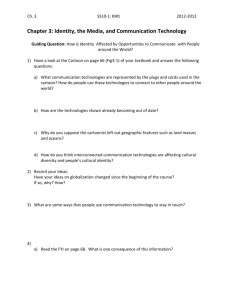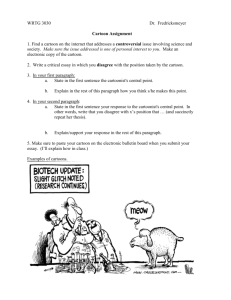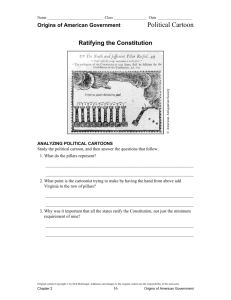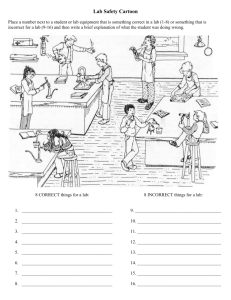Imperialism in Asia
advertisement
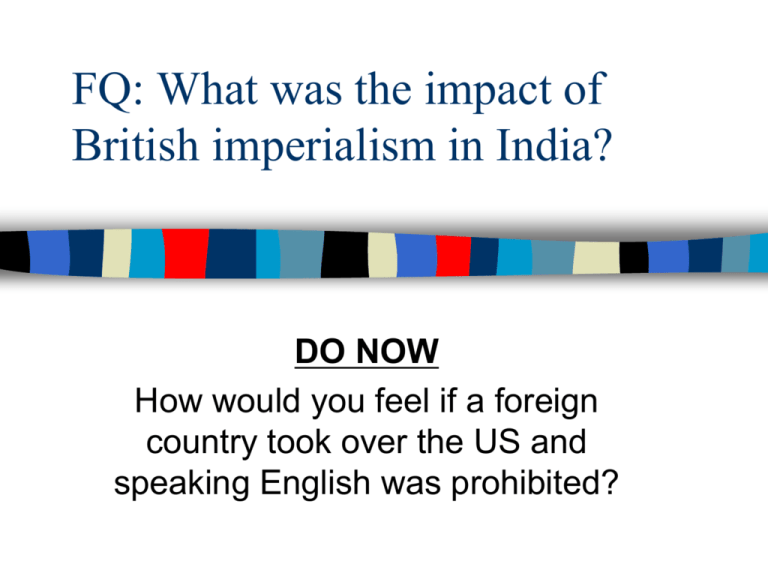
FQ: What was the impact of British imperialism in India? DO NOW How would you feel if a foreign country took over the US and speaking English was prohibited? Imperialism in Asia The Crusades & Age of Exploration caused interest in Asia because of the exotic goods like silk, spices, & gold Asia was the “treasure box” for explorers & imperialists: –In the 1500s, European trade with Asia began –In the 1800s, European imperialism in Asia began Change Over Time: World Imperialism India—the Jewel of the British Empire Imperialism in India During the Renaissance, the The East India Company had its British East India Company own army of Indian soldiers called became the richest & most Sepoys & a royal governor powerful company in world by controlling trade in India England gained so much trade in India that England used its force to rule most of India by 1857 Indian Nationalism The impact of British Imperialism in India: –Good: England built railroads, telegraphs, sewer & water systems, hospitals, & schools –Bad: England did not allow Indians to govern themselves; forced India to trade only with England, & converted farms to cotton plantations The Sepoy Mutiny In 1857, the Sepoy soldiers rebelled against the British when they Indians hired bythat England heard rumors the to serve soldiers bullets theyaswere using were coated with animal (cow or pig) fat The Sepoy Mutiny was crushed by the British army but revealed hostility between Indians & British The Bad: About 7 million Indians died during TheofGood: the famine 1876 Creating when theHospitals British forced & Teaching Nursingof food India to grow cotton instead Indian Nationalism In 1885, Indians demanded self rule & created the Indian National Congress to gain more control over governing India Led by Mahatma Gandhi, India finally gained its independence in 1947 Political Cartoon Analysis Identifying the Main Idea of the Political Cartoon Political cartoons are used to present a strong visual message or point of view on a topic of current interest. What political event or idea is the cartoon referring to? What key people or groups is part of the cartoon’s message? How has the cartoonist depicted these people? Explain any symbols used by the cartoonist to portray people or countries. Identify any captions, titles, labels, or speech bubbles in the cartoon. How do these contribute to the cartoon’s message? What is the message of this cartoon? How is the cartoonist trying to persuade the reader? Analyzing the Method Used by the Cartoonist Cartoonists use a number of methods to convey their message including humor, caricature (an exaggerated drawing in which features are distorted), satire, and symbolism. Use the questions below to help analyze the cartoonist’s method. Is the cartoon drawn realistically or are the characters distorted? Does the way the characters are drawn cast them in a positive or a negative light? Why do you think the cartoonist chose to use this style? Is the cartoon funny or is it serious? Explain how the method chosen by the cartoonist effectively conveys a political message. What drawings, captions, or labels does the cartoonist use to grab the reader’s attention? What did you notice first about the cartoon? Do you think cartoons are a good way to convey political messages Interpreting a Cartoon Who is/are the figure(s) in the cartoon (name, title, position)? When was it drawn (date or events associated with it)? What symbols are used? Which cartoonists’ devices are used (ie. Exaggerated physical features, props, clothing, positioning of figures)? What is the overall message of the cartoon? Why is the cartoon effective? What do you think is the message of this political cartoon? Interpret this political cartoon.

